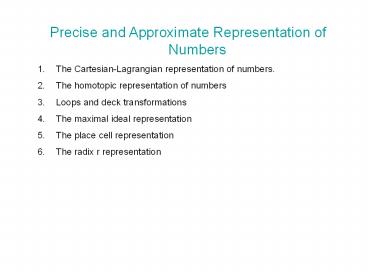Precise and Approximate Representation of Numbers - PowerPoint PPT Presentation
Title:
Precise and Approximate Representation of Numbers
Description:
Precise and Approximate Representation of Numbers The Cartesian-Lagrangian representation of numbers. The homotopic representation of numbers Loops and deck ... – PowerPoint PPT presentation
Number of Views:94
Avg rating:3.0/5.0
Title: Precise and Approximate Representation of Numbers
1
- Precise and Approximate Representation of Numbers
- The Cartesian-Lagrangian representation of
numbers. - The homotopic representation of numbers
- Loops and deck transformations
- The maximal ideal representation
- The place cell representation
- The radix r representation
2
Outline of the Day
930 - 1045 Part 1. Examples and Mathematical
Background 1045 - 1115 Coffee
break 1115-1230 Part 2. Principal
components, Neural Nets, and Automata 1230 -
1430 Lunch 230- 315 Part 3. Precise and
Approximate Representation of Numbers 1545 -
1615 Coffee break 1615 - 1730 Part 4.
Quantum Computation
3
The Usual Analog Computing Paradigm
Problems arise because of the dynamic range is
limited by noise, and because of the flows
often contain hyperbolic points that expand the
dynamic range. These considerations may make it
more desirable to compute the geometric mean
than the product, the average rather than the
sum. Some experience indicates that this
representation of data is limited to about one
part in 256, or eight bits. Moreover this
scheme is conceptually suspect in that it
suggests that it is possible to transmit
information perfectly from one location to
another at arbitrary transmission rates. It fails
to acknowledge either limited dynamic range or
limited bandwidth.
4
The Use of Time
Consider the representation of numbers via pulse
frequency modulation. If we can vary the pulse
rate from 1 Hz. to 106 Hz. then we Can represent
one part in 106. However, if we can not reliably
count pulses at a rate faster than one every T
seconds it will take Tx106 seconds to transmit
one number. These and other considerations
suggest that. In this setting it is worthwhile
to think of the communication constraints as
limiting the signal space to a subset of the
phase plane.
5
Channel Capacity
In this case the bit rate is ln 106 / Tx 106.
This model brings clearly into evidence the
limitations on communication speed. It is
impossible know both the value and the rate of
change because it takes time to transmit this
information. This suggests a strong limitation
on differential equations as computational
models. Place cell representations must be
specified by the lowest possible pulse rate and
the highest possible pulse rate. There are
systems used Just to give some numbers, there is
a part of the the auditory cortex for which
these numbers are 50 and 250 respectively.)
The representation of a curve as a time varying
convex combination of points.
6
Types of Quantizers
7
Types of Quantizers
8
The Pulse Annulus and its Winding Number
The annular characterization allows arbitrary
spacing between pulses, a characterization of a
set of functions that is very different from,
say, the characterization of band-limited
functions.
9
Computing with Pulse Representations
10
(No Transcript)
11
(No Transcript)
12
(No Transcript)
13
A Few Facts from the Topology of Adjoint Orbits
14
(No Transcript)
15
Moving Inverse Images Around
16
Using Systems with Many Stable Equilibria.
17
Robustness via Redundant Convex Combinations.
A second, completely different, way to achieve
robustness of the representation of a real number
is to represent it as the redundant weighted
combination of fixed numbers. The number is
represented by weights and a function of time is
represented by a an evolution in weight space.
In the place cell picture the weights are
organized topographically. It is also to think
of them as being the coefficients in a radix r
representation,
x(t) S ai(t)ri In this case there is no
redundancy however. More typically the situation
is as suggested On the right.
18
Probabilities on Vectors Spaces Lead to Averages
This representation of points is conceptually
different from averages In a probabilistic
setting but when implemented it looks almost the
same.
19
Conditional Density Flow Takes away More or Less
20
Computation with an Argmax (Place Cell)
Representation
Fact The conditional density for the usual gauss
markov process observed with additive white
noise evolves as a Gaussian. The argmax of a
Gaussian can be computed via the mean. Thus it
is possible to convert ordinary differential
algorithms into density evolution equations
which will do the same calculations. It seems
likely that the brute force way of doing this is
not the most efficient and from our knowledge of
completely integrable systems It seems likely
that one can find soliton equations that will
perform these calculations robustly.
21
Conditional Density Equation x Real Valued
22
The Argmax Representation
23
A Distributed (Argmax) Model for Analog
Computation
24
Summary of Part 3
1. Quantization is necessary for communication,
computation, reasoning and data storage. It must
be adapted to the computational hardware
available. 2. Topological invariants are
attractive examples of robust quantization and
can be related to computation in some cases.
There are arguments that show one can compute
with this type of representational scheme. 3.
We have illustrated the realization of finite
state machines using homotopy classes to
represent states. 4. Conditional probabilities
evolve and their evolution defines one of the
most basic analog computers.






























